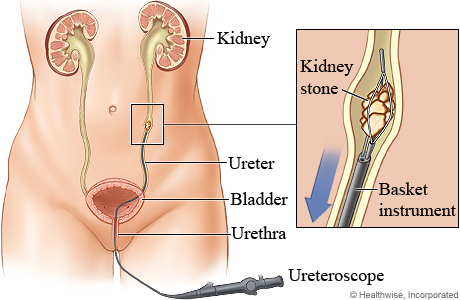Ureteroscopy: Overview
A ureteroscopy is a type of procedure. Your doctor may do it to remove kidney stones from one of your ureters. These are the tubes that carry urine from your kidneys to your bladder. Your doctor may also do it to help find the reason for a urinary infection or blood in your urine.
Your doctor puts a thin scope with very small tools in it into your urethra. This is the tube that carries urine from your bladder to the outside of your body. Then the doctor moves the scope through your urethra and bladder into your ureter.
The doctor may use a wire with a tiny basket on the end to take out a kidney stone. Or the doctor may use a laser to break up a stone. If this is done, the pieces will wash out of your body in your urine.
You may be awake during the procedure. Or you may have medicine to make you sleep. In either case, you will not feel pain.
Why is ureteroscopy done?
Urologists use ureteroscopy to remove stones that are stuck in the ureter and are closer to the bladder than the kidney (in the lower third of the ureter). But newer technology is allowing ureteroscopy to be used even for small stones in or near the kidney.
Ureteroscopy

During ureteroscopy, the doctor passes a thin viewing instrument (ureteroscope) through your urethra and bladder into your ureter. The doctor moves the scope through your ureter until it reaches the location of the kidney stone. No cuts are made in the body.
Your doctor can take out the kidney stone using a small "basket" that comes out of the end of the ureteroscope. Small stones can be removed all in one piece. Larger stones may need to be broken up before the doctor can remove them.
After ureteroscopy: When to call
Call 911 anytime you think you may need emergency care. For example, call if:
- You passed out (lost consciousness).
- You have chest pain, are short of breath, or cough up blood.
Call your doctor now or seek immediate medical care if:
- You have pain that does not get better after you take pain medicine.
- You have new or more blood clots in your urine. (It is normal for the urine to be pink for a few days.)
- You cannot urinate.
- You have symptoms of a urinary tract infection. These may include:
- Pain or burning when you urinate.
- A frequent need to urinate without being able to pass much urine.
- Pain in the flank, which is just below the rib cage and above the waist on either side of the back.
- Blood in the urine.
- A fever.
- You are sick to your stomach or cannot drink fluids.
- You have signs of a blood clot in your leg (called a deep vein thrombosis), such as:
- Pain in the calf, back of the knee, thigh, or groin.
- Redness and swelling in your leg.
Watch closely for changes in your health, and be sure to contact your doctor if you are having any problems.
©2011-2025 Healthwise, Incorporated
